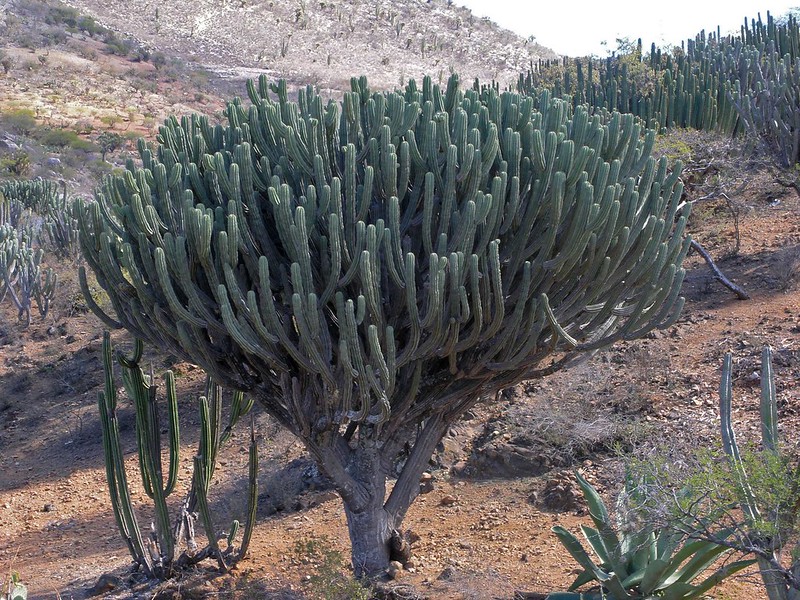Habitat: The Polaskia chichipe succulent cactus grows in xerophytic shrubland. Plants are treelike, branching more or less terminally to form distinct crowns up to 4 meters (13 feet) high, sometimes with distinct trunks. In Mexico, it is grown for its edible fruits and branches used as fuel wood. This low-maintenance plant requires somewhat full sun exposure.
Family: Cactaceae, subfamily; Cactoideae
Stems: Polaskia chichipe forms short main stems. However, it is somewhat curved, green, 7 cm (2.8 in) in diameter, and less than 1 meter (3.3 feet) long.
Ribs: The ribs are 9–12, acute, somewhat wavy, and 2 cm (0.8 inches) high.
Areoles: The deciduous areoles, when ripe, are in the depressions of the undulations, 1–1.5 cm (0.4–0.6 in) apart.
Spines: The spines are gray with dark tips.
Central spine: It is 1–15 mm (0.6 inches) long.
Radial spines: Polaskia chichipe radial spines are 6–8, 3–10 mm (to 0.4 inches) long.
Flowers: The flowers open at night, yellowish green to creamy white, 4 cm (1.6 in) long, 3–4 cm (1.2–1.6 in) in diameter; pericarpels lacking spines, bristles, or hairs.
Fruits: The spherical fruits are deep reddish purple, to 2.5 cm (1 in) in diameter. Globose is red.
Seeds: The seeds are about 1.2 to 1.4 mm long and bloom in March and June.
Soil: loam, sand, and well-drained.
Distribution: Puebla and Oaxaca, Mexico.
Elevations: 1500 to 2300 meters above sea level.
Usage: hedges and screens, beds, and borders.
Care: Polaskia chichipe grow meticulously and are cold-intolerant; keep them away from freezing temperatures or they could die. They require full sun, sparing only the hottest summer sun; if kept too dim, they may get too lush and green and may decay owing to excessive watering. If your Cereus outgrows its container, it might be essential to repot it; in that case, ensure sure the soil is completely dry before removing the pot. Feeding may not be essential if the soil is fresh; feed in summers only if the plant has not been replanted lately; and do not feed the plants after September since this might cause luxuriant growth, which can be dangerous during the darker, colder months.
Status: It exists in protected regions and is common, acceptable, and even encouraged in agricultural areas. It also poses no danger.
Synonyms: Cereus chichipe Roland-Gosselin 1905; Lemaireocereus chichipe (Roland-Gosselin) Britton & Rose 1920; Myrtillocactus chichipe (Roland-Gosselin) P. V. Heath 1992; Cereus mixtecensis. A. Purpus 1909; Lemaireocereus mixtecensis (J. A. Purpus) Britton & Rose 1920.
Attractions: This beautiful cactus species attracts different bird species.
Other Names: Chichibe, Chichipe, Chichitun, and Chichituna
Genus: Polaskia
Tribe: Pachycereeae
Order: Caryophyllales
Read More: Ferocactus cylindraceus (Engelmann) Orcutt 1926









